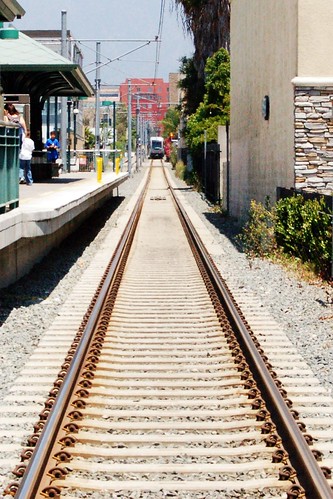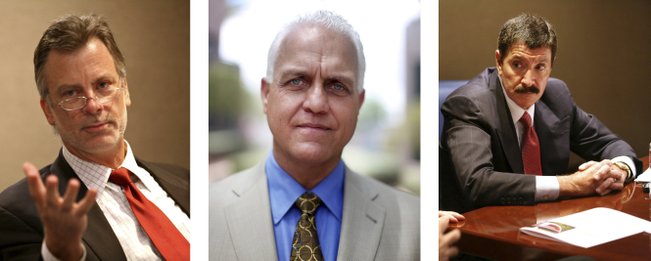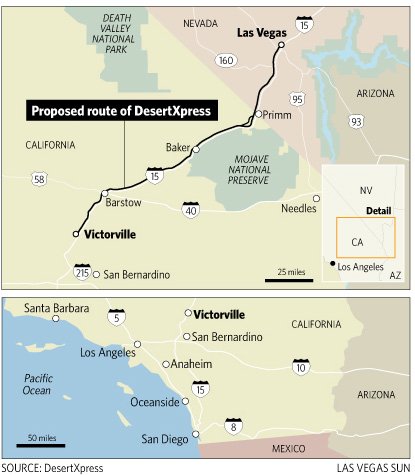From the Glendale New Press:
Link: Glendale News Press > Archives > Columns > START THE PRESSES:
It was a short, strange tripSTART THE PRESSES:
It was a short, strange trip
By DAN EVANS
Published: Last Updated Sunday, June 7, 2009 8:19 PM PDT
I left my house a little past 7 a.m. last week, enjoying the air on my mile-and-a-half bicycle jaunt to the Burbank Metrolink station. I waved to an old man in a Miami Dolphins cap, apparently startled by a business-wear and briefcase-clad man whizzing by before breakfast.
Distracted and sleepy, I nearly rammed into a woman in a red Volvo yammering into her Bluetooth. Oops. Need to remember the helmet.
It is six miles by car from my front door to the office. This is an intense blessing in an era of 90-minute, teeth-gnashing, oh-dear-god-the-101-is-backed-up-again commutes.
On an average day, it takes me about 15 minutes to get from Burbank to Brand Boulevard, and about 20 minutes to get home. If traffic is heavy, it may take a half-hour. Excepting when I lived six blocks from the newspaper where I worked, this is the best commute I’ve ever had.
But, due to the curiosity and masochism that comes with being a journalist, I wanted to see how easy it would be to take public transit.
Both Burbank and Glendale have bus systems, and both cities have made a concerted effort to attract riders. In addition, the Los Angeles County Metropolitan Transit Authority has literally hundreds of bus and subways lines. It’s a dead certainty that some combination of the three will take me where I need to go.
So I started my research. Transit schedules and bus maps cluttered my desk at work, mixed in with the letters, story pitches, freelancer invoices and empty coffee cups that form the detritus of my daily life.
Bus schedules are nearly impossible for the uninitiated, and I went cross-eyed trying to figure it all out. After a bit, I determined two ways to get from my home in Burbank to the world headquarters of the Burbank Leader and Glendale News-Press: One solely utilizes the Glendale Beeline, while the other uses an MTA bus.
There is a way to get between Glendale and Burbank using Metrolink. However, as it costs more than three times as much as any other method — $8.25 for a round-trip — I did not seriously consider it. Additionally, as the Burbank bus does not go into Glendale, I could not use it as part of the experiment.
The Glendale Beeline — Bikes, Buses and Blisters
Cost: $1 one way; $2 round trip
Travel time: 62 minutes
Total mileage via public transit: 3.5 miles
Mileage by foot/bike: 2.7
Ouch. I guess business wear isn’t the best for treks down Burbank and Glendale streets. By the time I got to the office, I had biked or walked nearly as far as I had traveled by bus. My choice of footwear was poor, I’ll admit, as office-type shoes are nearly guaranteed to cause blisters after about a mile.
I left my house at 7:15 a.m., jumping on my bike for a pleasant mile-and-a-half jaunt down Victory Boulevard. I got to the Burbank Metrolink station about 10 minutes later, in plenty of time to catch the 7:35 a.m. Glendale Beeline. The line I took, Route 12, waits for passengers from the Metrolink 104 train to arrive before taking off. That train is supposed to arrive at 7:30 a.m., but if it’s late, the Beeline waits.
The day I took it, however, Metrolink was on time, and the Beeline took off on schedule. The Beeline is free with a Metrolink pass. Since I biked to the station, however, I had to pay the $1 fare. The bus dropped me off at San Fernando and Broadway at 7:50 a.m., and it took me 27 minutes to walk the 1.2 miles to the office.
Though this line is convenient for Metrolink users who work along the San Fernando corridor, it’s not especially practical for anyone else.
MTA Bus 183 — Going Metro
Cost: $1.25 one way; $2.50 round trip
Travel time: 45 minutes
Total mileage via public transit: 8.1 miles
Mileage by foot/bike: 0.5 miles
This is the winner by quite a bit. The nearest bus stop is less than a 10-minute walk from my front door, and drops me off two blocks from the office. The bus is comfortable and not especially crowded. Amazingly, the bus driver appeared to know all of her regulars by name, something that seems almost anachronistic in a county of 13 million souls.
Now, the downside: The bus runs only once an hour. For me, this means getting to work 15 minutes early or 45 minutes late. And, on the way home, it means sticking around for an additional hour if things run long. Also, the bus runs a weirdly circuitous route in the neighborhoods above Glenoaks Boulevard, adding 20 minutes to what would be a nearly perfect commute for me.
But of course, that’s the point. The bus route is for the public, not for me specifically. If you are willing — or required — to take public transit, you take that as part of the deal.
Looking at the routes of the three systems, it seems fairly clear that the MTA is for travel between cities, while the Glendale and Burbank systems are for intra-city travel. Because of this, I’m not surprised that the MTA turned out to be the best for me.
However, two problems will continue to plague all bus systems: time and convenience. The fastest method I could take via public transit takes three times as long as it would by car. And, since I’m driving only six miles, it’s hard to see how I’m saving much in the way of gas and wear on my car by not driving.
I would love to take public transit more, but right now it seems like it’s still too much to give up. It may make more sense, and certainly fewer blisters, to just take my bike to work. I’ll let you know how that works out.



 Posted: 06/10/2009 04:52:44 PM PDT
Posted: 06/10/2009 04:52:44 PM PDT







